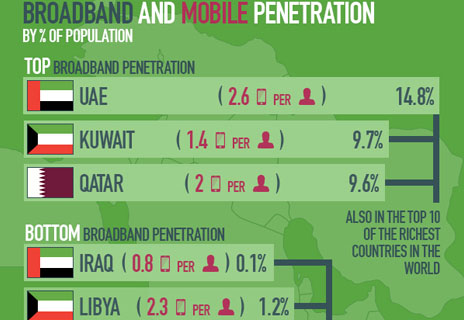
Eastern promise: Middle East internet habits infographic

Our latest infographic shows the latest stats and trends from the region.
View infographic Currently it makes up almost 4% of internet users worldwide but this figure could be higher. Broadband initiatives and a predominately young population are driving internet growth. You may be thinking “Why bother with a region that has a low percentage of users?”. The potential and opportunity in the region for mobile and products/services targeted at under 24s is huge. Two of the most striking aspects of the Middle East that differentiate it from the rest of the world are:- High mobile and smartphone ownership – many people have their first internet experience via mobile
- 53% of the population are under 24, a significant figure in comparison to the USA, China and Western Europe where it is 16-20%.
Internet growth
Broadband penetration across the region is low, which has driven mobile ownership up. However, initiatives such as national broadband networks are underway in the UAE, Qatar, Oman and Bahrain to address this. Easy-to-access, reliable and quick internet will transform this region.Broadband penetration across the region is low, which has driven mobile ownership up.Users prefer to access the internet in Arabic or English. Arabic is the fastest growing internet language, with a 2,501% increase over the last ten years.
Power of youth
Generation Y and Z (also known as the “Millennials”) are driving digital change. Whatever you call them, they are a force that will have a dramatic impact on how the Middle East consumes digital media and in the direction it will take technologically.53% of the population are under 24.They use social media at least once a day, share content online and prefer internet to TV. While Facebook, Twitter and YouTube continue to gain popularity, it will be interesting to see what technology innovators and entrepreneurs the region will produce in the next few years.
Making connections
Facebook is the overwhelming choice for social media with over 24 million users. While Twitter lags behind with 1.5 million users, it has grown rapidly over the last two years. Social media highlights a gender gap - 34% of women use it compared to a world average of 61%. Reasons for this include societal and cultural limitations, lack of access to IT and security concerns.Only 34% of women use social media compared to 61% worldwide.The Middle East loves video and is second to the USA for YouTube views with over 167 million a day. Considering the lack of broadband penetration, this is significant. Video has many advantages over written content – it can overcome language barriers and be quicker and easier to consume.
Creating a marketing strategy for the Middle East
As with any international digital marketing strategy, you should always drill down to a country level – what applies for one country does not necessarily apply to its neighbour. Areas to consider are:- Language – pick the right one to deliver your message or create multi-lingual websites and content.
- Mobile – a mobile/responsive website or app will make your company more accessible. Design is important. Email and SMS are also good tools to use.
- Video – this audience loves watching it so it can be an effective way to get your message across.